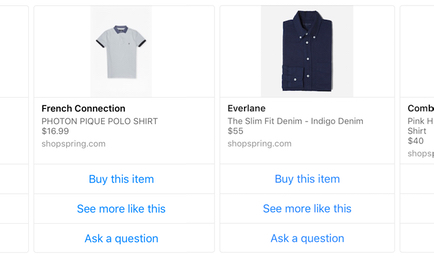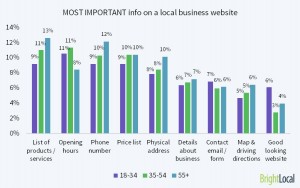Facebook made a big splash at its F8 developer conference last week, with the announcement of a new API for its Messenger service, which allow brands to interact with customers via bots.
With bots comes the promise real “conversational commerce”—100% automated and scalable.
From Facebook PR:
“Bots can provide anything from automated subscription content like weather and traffic updates, to customized communications like receipts, shipping notifications, and live automated messages all by interacting directly with the people who want to get them.”
And if bots catch on, they could be a big deal. While most smartphone owners won’t download your app, they will be able to reach you via a messaging app. According to eMarketer, messaging app user penetration is projected to exceed 68% by 2019.

Ecommerce shopping destination Spring was one of Facebook’s launch partners. Spring co-founder Alan Tisch talked with the NYT about why his company signed up:
“Conversing with a chatbot to shop feels ‘magical,’ Mr. Tisch said, though in reality, much of commerce is happening through the conversations we’re already having all the time.”
Sure, it might seem magical. But are bots worthy of your time? What can bots really do for your business? What about the idea of giving Facebook more control over the interactions you have with your customers than it already has?
Well, that last one’s up to you. But this post will try to answer the other two. This is our chat bot primer for retailers. Read on!
An early glimpse into chatbot shopping on Facebook
Shopping chatbots are still in their early stages. Spring’s Facebook Messenger interface is pretty rudimentary; it’s basically just a chat-based way to interact with mobile product recommendations.
Here’s the opening screen:

Once you narrow it down by gender and price range, a product carousel pops up and you can further refine your query, but only through a product recommendation-esque “show me more like this” interface. There’s currently no way to interact with the bot to further hone your results in a more intuitive manner (i.e. “just show me the gray polos”).

But the simple, uncomplicated first incarnation of Spring’s Messenger experience is kind of the point. The big hope and promise of shopping chatbots is that they learn and get better over time.
Here’s how Facebook’s David Marcus explained it during F8:
“You feed the bot engine with sample conversations, then it can handle any variation of that conversation on its own, using artificial intelligence and machine learning. It gets better and better over time. You don’t need to do any coding. It will do the job for you.”
Sounds pretty good. But will it really pan out technically, not to mention socially?
Maybe the chatbot future isn’t so close after all.
Great, automation and machine-learning technology have now evolved to the point where we can use them to buy stuff. But do people actually care? Will chatbots teach themselves to do enough tasks, well enough, that we will:
- Trust them to get it right
- Find that it actually saves us time
- Think it’s a better experience than searching, browsing, and buying the old-fashioned way
Motherboard took another chatbot-enabled messaging app, Kik, for a test shop. The result…
“…wasn’t very stimulating. H&M directed me towards bundled looks; Funny or Die basically found another medium for encouraging me to LIKE or DISLIKE its content. It made me feel like Chatbots are going to end up missing the part where they try to be my friend. Instead, they are just cutting to the chase and trying to sell me something, or push something my way for their own good.”
Similarly skeptical, Bloomberg wonders if millennials will be swooned by chatbots:
“Although the majority of America’s millennials use Facebook, their approach to online shopping is systemic and drawn out, not necessarily in line with the immediate call-to-action button. ‘The average millennial might look at as many as 10 reviews to make a purchase,’ said Nora Ganim Barnes of the Center for Marketing Research. ‘Is Messenger going to work to do that? I don’t think so. I think it’s missing too many pieces that people have come to rely on and enjoy.”
I think Bloomberg is missing the point here. Brands aren’t assuming (or even hoping) that chatbots will take over every aspect of the shopping experience. They think it might make for faster and more convenient shopping and enable better customer service.
Retail Dive explored this possibility of customer-service bots and found that:
“app-like chatbot software automates customer service tasks that are now commonly offered via phone and email. These ‘bots’ can provide customized communications from businesses like receipts, shipping notifications and live automated messages, ‘all by interacting directly with the people who want to get them.’”
But there are also some risks to automating customer service interactions, and when customer requests get more involved than retrieving a receipt or setting up a return, bots may not be able to help.
To bot or not to bot?
Of course, there are times when bots will be perfect for the job, and times when a human touch is needed. For a great roundup of times in which bots are probably fruitful to deploy, check out this Re/code article. The first point from their article:
“Interactions must be quick. If a conversation with a bot takes more than a handful of messages, it almost certainly would have been quicker and more efficient using a touch-based Web or app interface. The fewer the number of back-and-forth exchanges, the better suited a task is to a bot interface. Typing out endless responses to questions rather than simply pressing buttons makes the model unworkable.”
Indeed.
Hyatt hotels is one brand that has adopted a hybrid approach. Their travel ecommerce team responds to guests on Twitter 24/7/365. Dan Moriarty, Hyatt’s digital director, described the strategy for his company as a hybrid approach:
“‘Bots might be useful to take care of some basic booking functions through a platform like Messenger, but not for customer service. If there is a way to use a bot, it would be when a guest wants a transactional interaction to occur quicker, and a bot would be quicker, but we’re not looking at a reduction in the human kind of connection. There’s a heavy sensitivity toward people wanting to talk to each other,’ Moriarty said.”
This is the approach for which ecommerce guru Richie Siegel advocates:
“The best chat interfaces will have a hybrid approach, using chat bots for programmable communication and then following up and reinforcing it with human-to-human conversations. Let’s start by looking at discovery and service, two pillars of commerce, through the lens of the funnel.”
The big opportunity for bots, Siegel goes on to explain, is in discovery, a problem that’s largely unsolved, especially in when it comes to mobile ecommerce.
Conclusion
That’s the end of our chatbot crash course for retailers. We’ll keep following retail chatbots and sharing what we learn.
Digital & Social Articles on Business 2 Community(64)
Report Post






